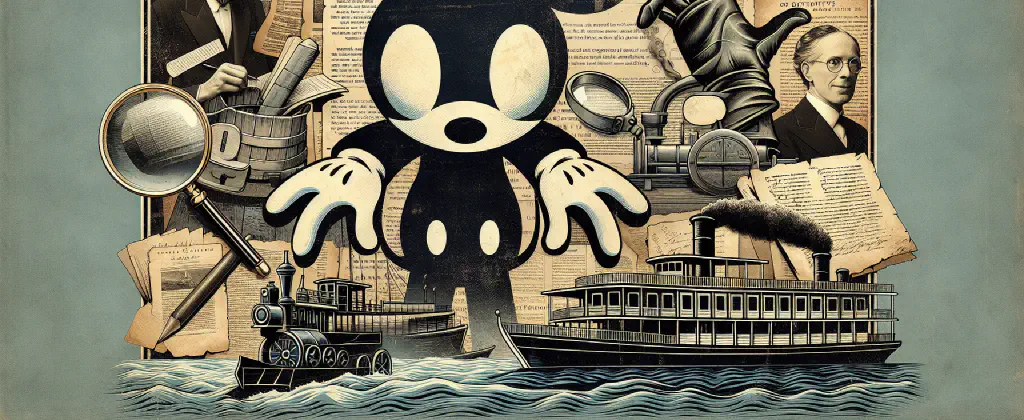12. December 2023
The Fading Copyright of Mickey Mouse: What Will Enter the Public Domain in 2024?

Disney fans and enthusiasts of classic literature have something to look forward to in 2024. Several notable works are set to enter the public domain, including books by renowned authors such as Agatha Christie, W.E.B. DuBois, Evelyn Waugh, Nabokov, D.H. Lawrence, H.G. Wells, Virginia Woolf, and A.A. Milne. Even theatrical pieces like Bertolt Brecht’s “The Threepenny Opera” and Eugene O’Neill’s “Strange Interlude” are among the works to be freed from copyright restrictions. It’s an exciting time for bookworms and theater lovers alike.
However, the public domain status of certain works can be a complicated matter, especially when it comes to iconic characters like Mickey Mouse. In recent years, there has been speculation regarding the copyright status of the beloved cartoon character and whether he would enter the public domain alongside his early films, such as “Steamboat Willie.” The implications of this are intriguing, prompting discussions about the future of Disney’s trademark and the potential for derivative works featuring the classic, rubber hose Mickey.
But how does the copyright law apply to characters like Mickey Mouse? Let’s unpack the complexities and shed some light on the situation.
The Complexity of Copyright Laws
The discussion surrounding the entry of Mickey Mouse into the public domain involves various legal aspects, depending on the country and the specific laws in place. While some countries follow a “life+70” rule, which grants copyright protection for 70 years after the author’s death, others enforce a hard copyright expiration date. For example, in the United States, works published before 1928 are set to enter the public domain in 2024 due to the fixed copyright term.
The United States copyright regime has often been critiqued for its complexity. However, it’s worth noting that the U.S. did adopt a life+70 rule for works published after 1978, following the lead of other countries. This change helped align the U.S. with international copyright standards, but works published before this switch are still governed by the old system. Despite its complexities, this system prevents even more retroactive copyright extensions, which could have significant adverse effects on the public domain.
Mickey Mouse and Copyright Interactions
One of the most fascinating aspects of the Mickey Mouse copyright discussion is how it interacts with other forms of intellectual property laws, such as trademark and fair use. For instance, Disney Animation has been using a clip from “Steamboat Willie” as their opening bumper, paying tribute to the character and Walt Disney himself. However, questions have been raised about whether the use of “Steamboat Willie” in the bumper would infringe on Disney’s copyright for the film.
It has been suggested that using “Steamboat Willie” in the bumper could be seen as a violation of Disney’s trademark, rather than copyright. The argument is that the use of the character implies endorsement by Disney and could potentially infringe on their trademark rights. Nonetheless, it’s important to note that the copyright to the film itself will expire, allowing for potential non-infringing uses.
Trademarks, Derivative Works, and the Changing Landscape
While Disney’s connection to Mickey Mouse is undeniable, it’s crucial to recognize that the character’s significance to the company has evolved over time. In recent years, Disney’s business has expanded through large acquisitions, making Mickey Mouse just a small fraction of their overall worth. Consequently, the upcoming public domain status of the old design of Mickey may not significantly impact Disney’s current operations.
Furthermore, creating derivative works based on early versions of Mickey Mouse might present challenges in terms of trademark protection. If someone were to use the original “rubber hose” Mickey in their creations, they may face difficulties in selling those derivative works, due to potential trademark infringement. However, the availability of Mickey’s old design in the public domain opens up creative possibilities for those willing to navigate the legal landscape.
The Power of Branding and the Association with Disney
One intriguing aspect of the Mickey Mouse copyright debate is the powerful connection established between the character and Disney’s branding. Despite minimal exposure to classic Mickey Mouse cartoons, many people still associate Disney with Mickey and Minnie. This illustrates the remarkable impact of branding and the lasting imprint Disney has made on popular culture.
It is important to recognize that intellectual property laws, including copyright and trademark, play a significant role in shaping these associations. While copyright laws protect creative works, trademarks safeguard brands and help prevent unauthorized use that may imply endorsement or confuse consumers. The unique connection between the Disney brand and Mickey Mouse is a testament to the power of effective branding and the enduring influence of iconic characters.
Looking Ahead: The Impending Public Domain of Mickey Mouse
As the year 2024 approaches, discussions about the public domain status of Mickey Mouse will undoubtedly continue. The implications for Disney, the creative world, and copyright law will be fascinating to observe. Will Disney try to prevent Mickey Mouse from entering the public domain, or will they embrace the evolving landscape and explore new creative avenues?
While the copyright expiration of early Mickey Mouse films, like “Steamboat Willie,” may lead to challenges regarding derivative works, the public domain status offers exciting opportunities for artists and creators to reimagine the classic character within legal bounds. Whether it’s through timeless literature, theatrical works, or iconic characters like Mickey Mouse, the shifting copyright landscape will continue to shape our cultural experiences and inspire new generations of creators.
So, mark your calendars for 2024. It promises to be an eventful year as beloved works enter the public domain and the realm of creativity expands even further. The fading copyright of Mickey Mouse is just one piece of the puzzle, but it reflects the intricate and ever-changing tapestry of intellectual property laws, trademarks, and artistic expression. Let the countdown to 2024 begin, as we eagerly anticipate the new possibilities that lie ahead.